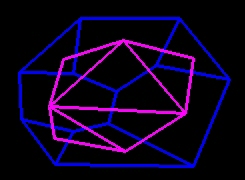
three successive truncation of a tetrahedron lead to tectohedra of orders 4, 5 and 6,
with one, two and three ridge-pole edges
on the right a LiveGraphics3D animation with these three truncations

three successive truncation of a tetrahedron lead to tectohedra of orders 4, 5 and 6, with one, two and three ridge-pole edges on the right a LiveGraphics3D animation with these three truncations |
|
| properties:
tectohedron of order n (the base is a n-gon) |
• the tetrahedron is a special case: only one vertex, no ridge-pole edges,
• every pentahedron is a tectohedron of order 4 and it is so in three different ways (three quadrilateral faces), • the number of triangular faces is contained between 2 and n/2 and two such faces are not adjacent, • there are (n-2) vertices and (n-3) ridge-pole edges, • for every n there is a tectohedron with two bases (it looks like a "wedge" with two n-gons), • every tectohedron without ridge-pole edge parallel to the base stems (by successive truncations) from a tetrahedron, otherwise it stems from a pentahedron with three parallel edges. |
| exercises:
solutions |
• Starting from a base polygon construct the top view of a tectohedron.
Indication: draw a tetrahedron from which the tectohedron stems (see "cutting a tetrahedron"). Can the vertex of the tetrahedron be chosen outside of the base polygon? • Construct the net of such a tectohedron, then build it. |
Here we are interested in the topology, that means in the nature and the layout of the faces. Roger Iss assigns a formula to each tectohedron by associating to each face the number of ridge-pole edges among its sides. So one can determine the different classes of tectohedra by recurrence on the order. To each truncation corresponds a numeric manipulation easy to program on a computer. For more details see the document in reference.
| The top view can be transformed by "duality": in each lateral face chose an arbitrary point, then link the points corresponding to adjacent faces (to each lateral or ridge-pole edge corresponds then a line segment). Thus we get a n-gon - which can be chosen convex - triangulated in (n-2) triangles by (n-3) diagonals
We find the formula by associating to each vertex the number of diagonals which start from it. A truncation corresponds to the augmentation of the n-gon by a triangle (the common side is then a diagonal of the (n+1)-gon). |  |
T4 = 1 T5 = 1 T6 = 3 T7 = 4 T8 = 12 T9 = 27 T10 = 82 ... T15 ≈ 25000 ... T20 > 107 ...

|
quadrilateral |
parallelogram (pentahedron with parallel edges)
|
quadrilateral circumscribed to a circle |
pentagon |
pentagon with three concurrent bisectors |
pentagon circumscribed to a circle |
The third property above implies that a ridge-pole edge belongs to the bisector plane of the base's sector defined by the concerned edges; on the top view it is a bisector's segment of the sector. The second property adds of course a supplementary constraint.
A polygon which has an inscribed circle (⇔ its interior bisectors are concurrent) produces a pyramid and the center of the circle is the orthogonal projection of the apex. More generally if at least three bisectors of the base are concurrent then the number of ridge-pole edges decreases and the number of triangular faces increases (there are then adjacent ones).
| references: |
• Les tectoèdres by Roger Iss (Bulletin de l'APMEP n° 402, February 1996) - pdf (120 Kb, in French)
• La géométrie des tas de sable ou les surfaces "d'égale pente" by Robert March (Bulletin de l'APMEP n° 442, September 2002, in French) • Sable et mathématiques by Roger Iss (L'Ouvert n° 41, December 1985 & n° 42, March 1986) - PDF (540 Kb, in French) • La géométrie des tas de sable (Tangente n°94, September-October 2003 & Tangente sup n°21, October 2003, in French) • the site by Roger Iss Une curieuse famille de polyèdres : les tectoèdres (in French) • Les tas de sable au club... scientifique by Francis Jamm (lycée Lavoisier, Mulhouse) - PDF (1,2 Mb) - PDF-2 (1,2 Mb), both in French • the web site of the scientific club of lycée Lavoisier in Mulhouse (France) • pages from the web site of lycée Lavoisier in Mulhouse (in French & English) • a page from mathcurve.com surfaces d'égale pente (in French) La science des châteaux de sable (blog of David Louapre, in French) |
home page
 |
convex polyhedra - non convex polyhedra - interesting polyhedra - related subjects | April 2008 updated 23-04-2008 |